Abstract
Detection of new ligand-defective mutations of apolipoprotein B (apoB) will enable identification of sequences involved in binding to the LDL receptor. Genomic DNA from patients attending a lipid clinic was screened by single-strand conformation polymorphism analysis for novel mutations in the putative LDL receptor-binding domain of apoB-100. A 46-yr-old woman of Celtic and Native American ancestry with primary hypercholesterolemia (total cholesterol [TC] 343 mg/dl; LDL cholesterol [LDL-C] 241 mg/dl) and pronounced peripheral vascular disease was found to be heterozygous for a novel Arg3531-->Cys mutation, caused by a C-->T transition at nucleotide 10800. One unrelated 59-yr-old man of Italian ancestry was found with the same mutation after screening 1,560 individuals. He had coronary heart disease, a TC of 310 mg/dl, and an LDL-C of 212 mg/dl. A total of eight individuals were found with the defect in the families of the two patients. They had an age- and sex-adjusted TC of 240 +/- 14 mg/dl and LDL-C of 169 +/- 10 mg/dl. This compares with eight unaffected family members with age- and sex-adjusted TC of 185 +/- 12 mg/dl and LDL-C of 124 +/- 12 mg/dl. In a dual-label fibroblast binding assay, LDL from the eight subjects with the mutation had an affinity for the LDL receptor that was 63% that of control LDL. LDL from eight unaffected family members had an affinity of 91%. By way of comparison, LDL from six patients heterozygous for the Arg3500-->Gln mutation had an affinity of 36%. The percentage mass ratio of the defective Cys3531 LDL to normal LDL was 59:41, as determined using the mAb MB19 and dynamic laser light scattering. Thus, the defective LDL had accumulated in the plasma of these patients. Using this mass ratio, it was calculated that the defective Cys3531 LDL particles bound with 27% of normal affinity. Deduced haplotypes using 10 apoB gene markers showed the Arg3531-->Cys alleles to be different in the two kindreds and indicates that the mutations arose independently. The Arg3531-->Cys mutation is the second reported cause of familial ligand-defective apoB.
Full text
PDF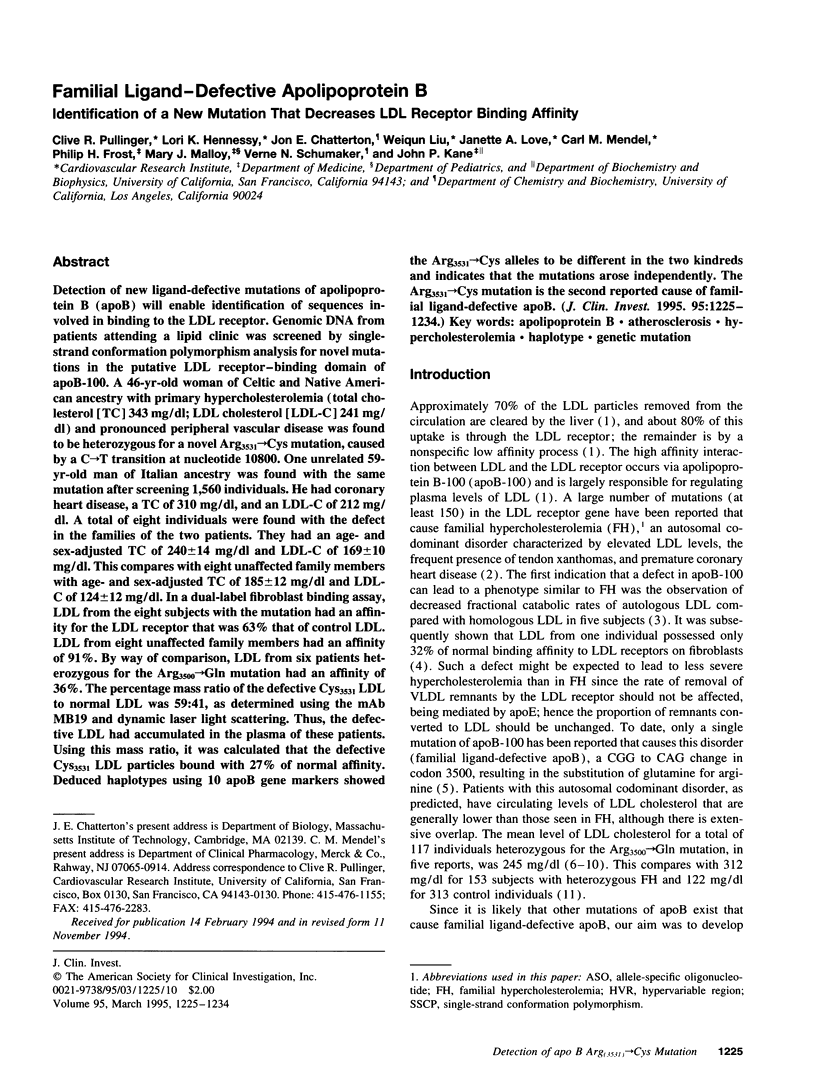
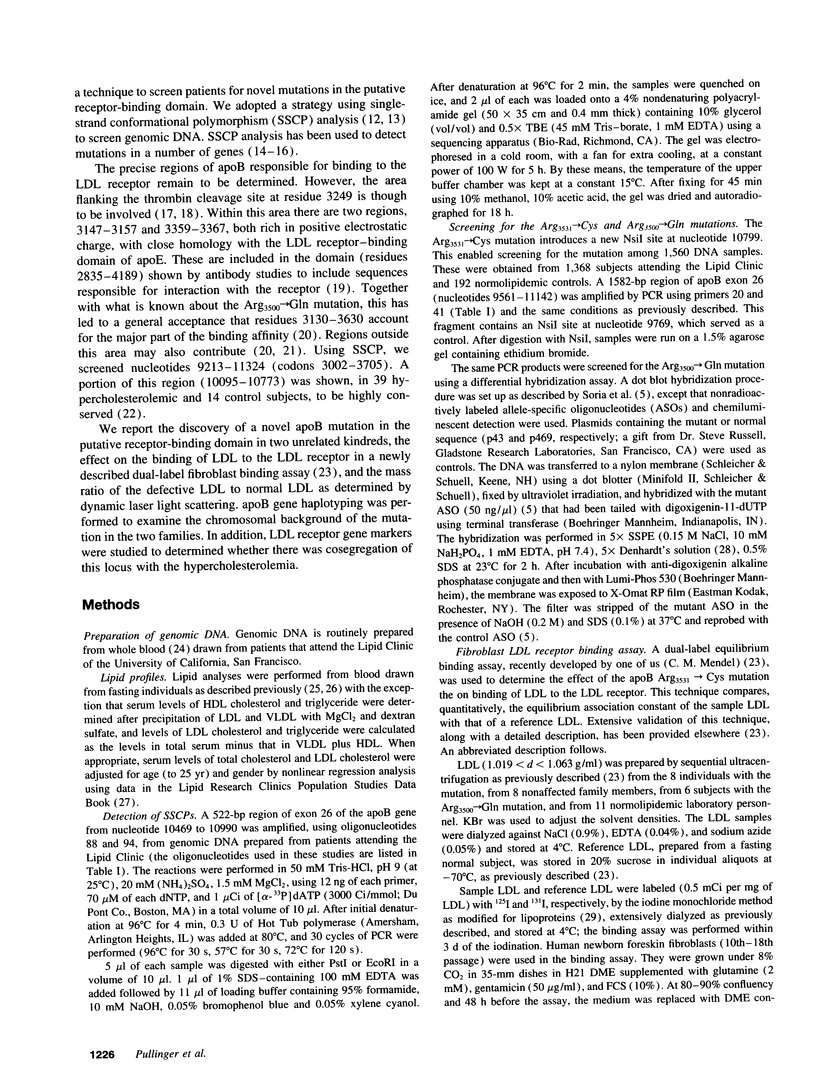
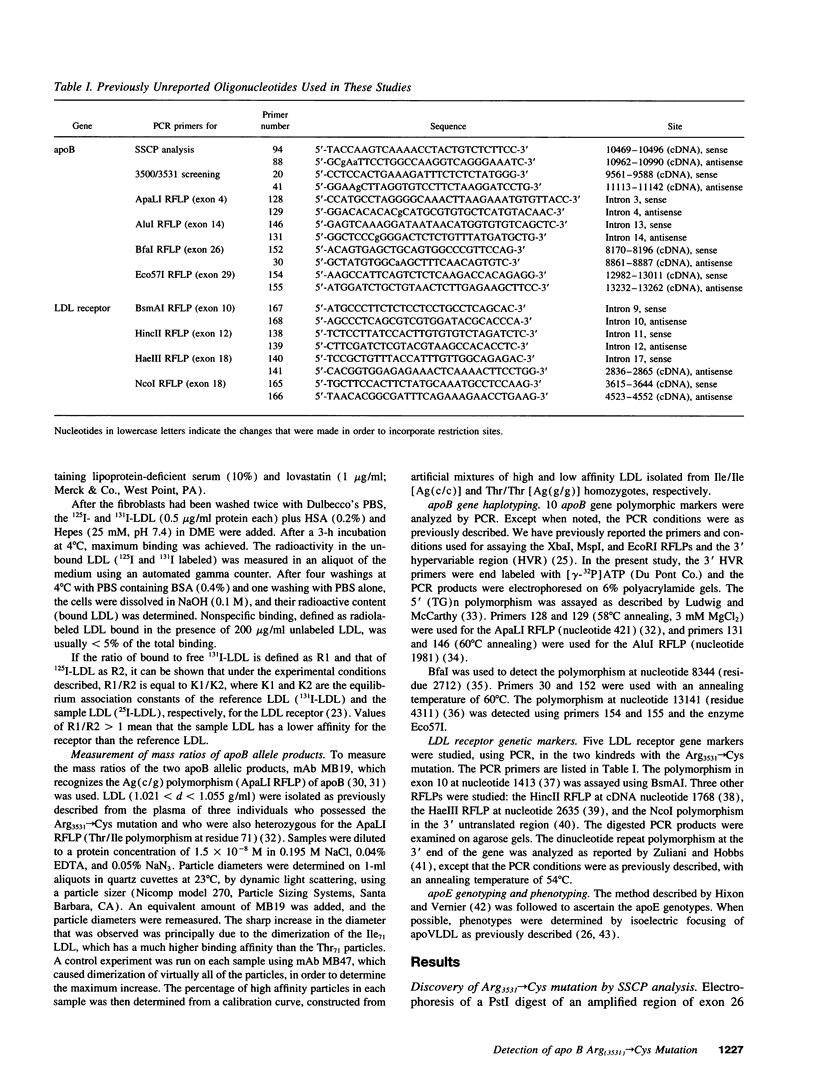
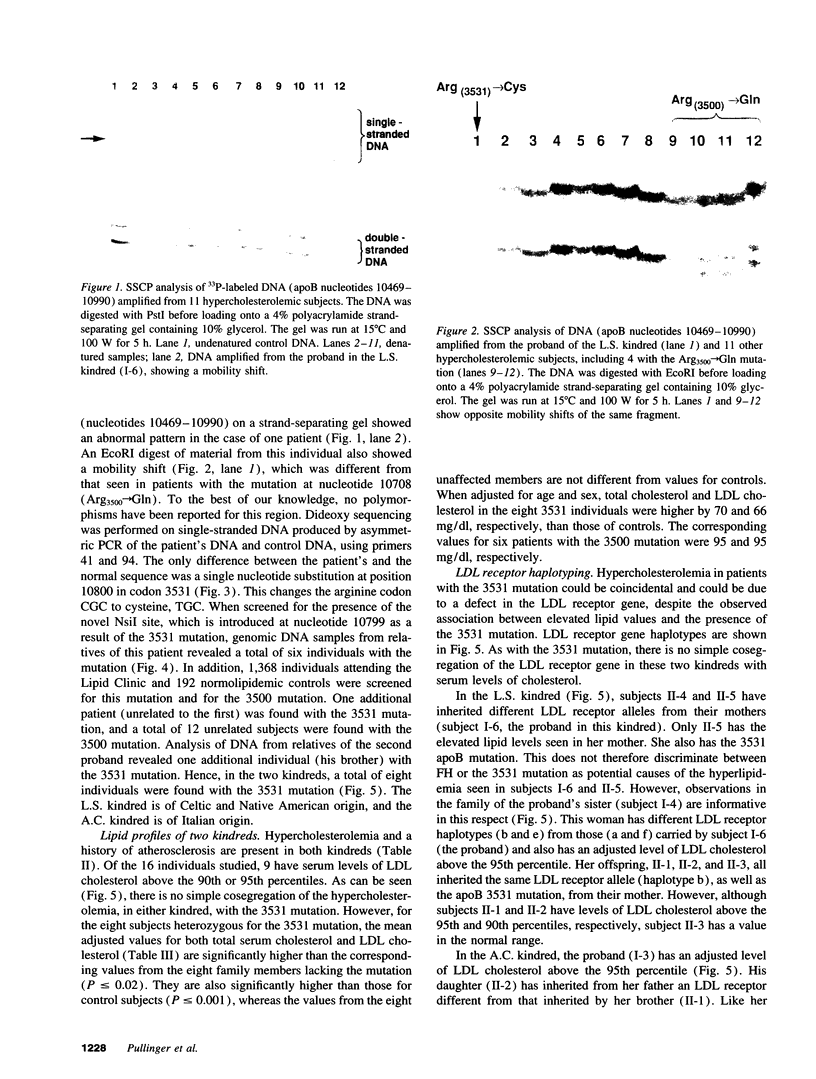
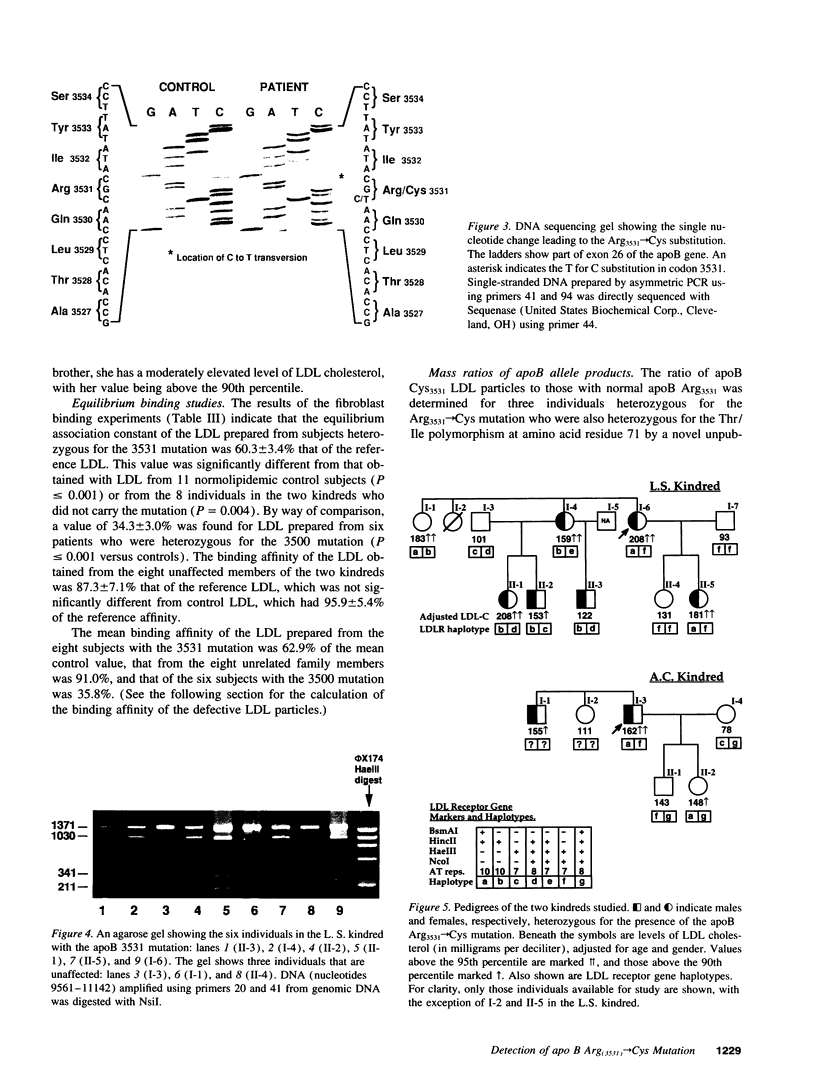
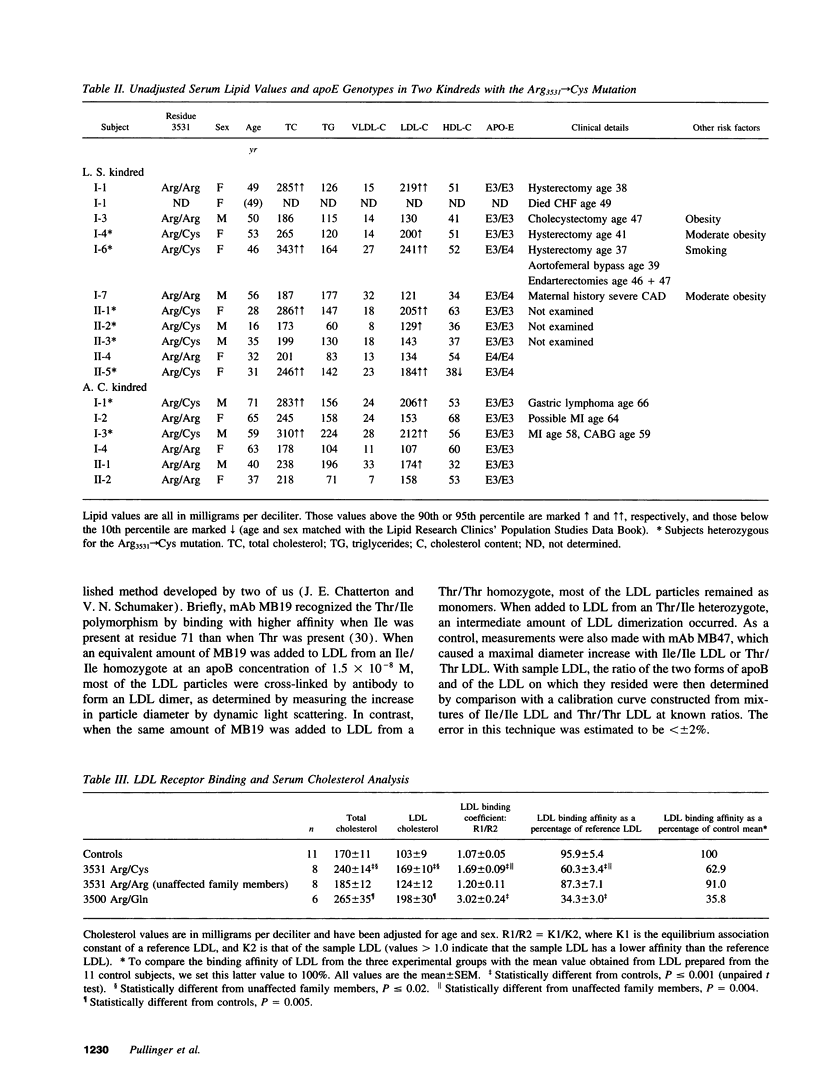
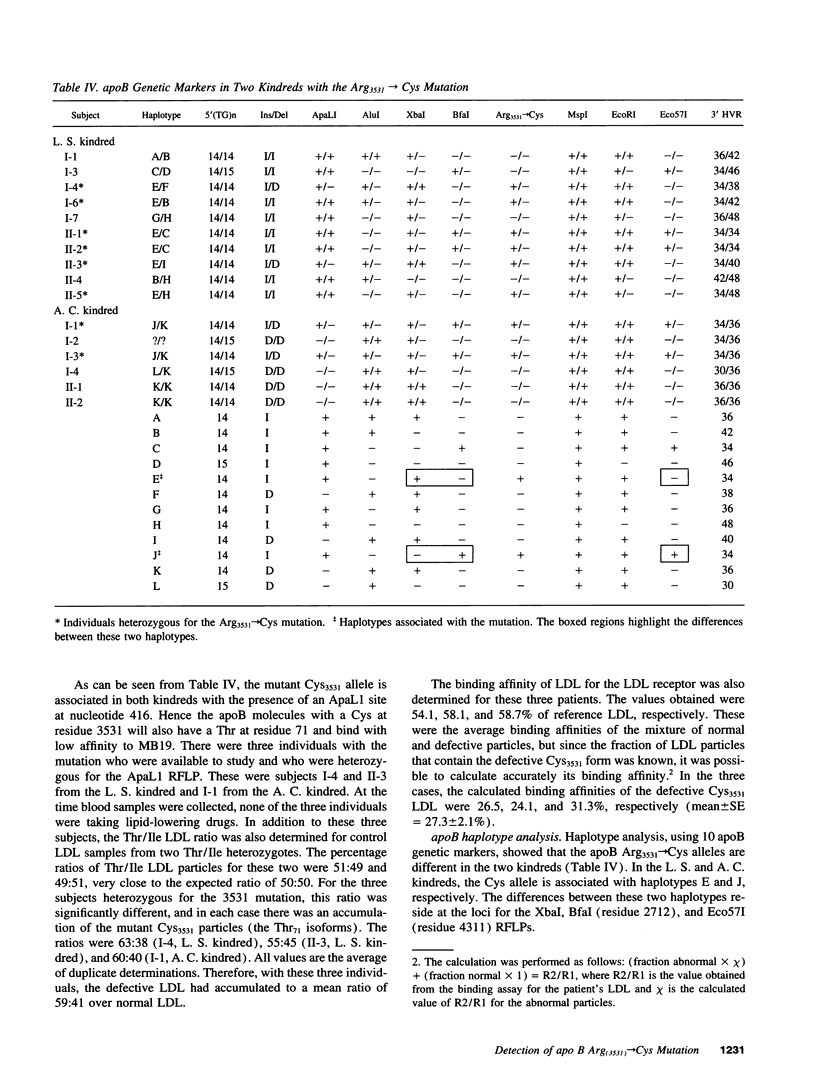
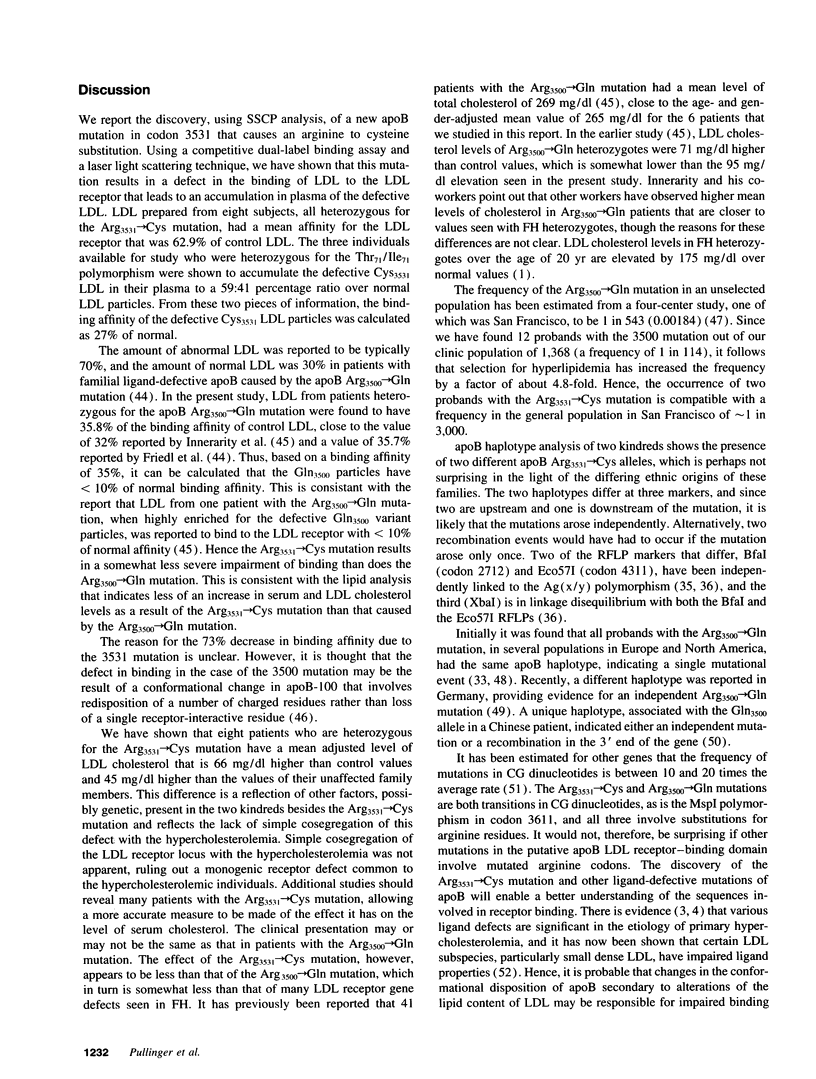

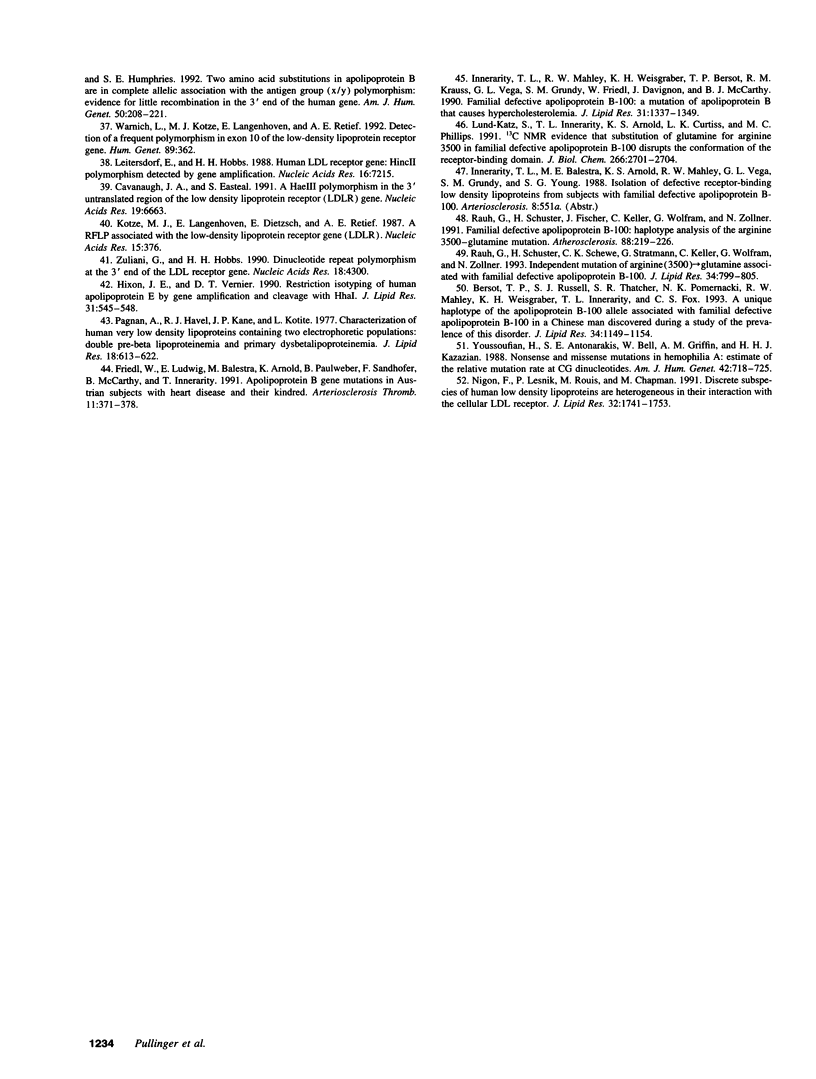
Images in this article
Selected References
These references are in PubMed. This may not be the complete list of references from this article.
- Avoustin P., Mostachi H., Perret B., Cambou J. P., Cambien F., de Préval C. A very conservative region of ApoB-100 in the putative binding region to the LDL receptor in the Toulouse population. Hum Genet. 1992 Dec;90(4):460–463. doi: 10.1007/BF00220478. [DOI] [PubMed] [Google Scholar]
- Bell G. I., Karam J. H., Rutter W. J. Polymorphic DNA region adjacent to the 5' end of the human insulin gene. Proc Natl Acad Sci U S A. 1981 Sep;78(9):5759–5763. doi: 10.1073/pnas.78.9.5759. [DOI] [PMC free article] [PubMed] [Google Scholar]
- Bersot T. P., Russell S. J., Thatcher S. R., Pomernacki N. K., Mahley R. W., Weisgraber K. H., Innerarity T. L., Fox C. S. A unique haplotype of the apolipoprotein B-100 allele associated with familial defective apolipoprotein B-100 in a Chinese man discovered during a study of the prevalence of this disorder. J Lipid Res. 1993 Jul;34(7):1149–1154. [PubMed] [Google Scholar]
- Bertolini S., Coviello D. A., Masturzo P., Zucchetto E., Elicio N., Balestreri R., Orecchini G., Calandra S., Humphries S. RFLPs of the LDL-receptor gene: their use in the diagnosis of FH and in evaluation of different levels of gene expression on normal subjects. Eur J Epidemiol. 1992 May;8 (Suppl 1):18–25. doi: 10.1007/BF00145345. [DOI] [PubMed] [Google Scholar]
- Bilheimer D. W., Eisenberg S., Levy R. I. The metabolism of very low density lipoprotein proteins. I. Preliminary in vitro and in vivo observations. Biochim Biophys Acta. 1972 Feb 21;260(2):212–221. doi: 10.1016/0005-2760(72)90034-3. [DOI] [PubMed] [Google Scholar]
- Cavanaugh J. A., Easteal S. A HaeIII polymorphism in the 3' untranslated region of the low density lipoprotein receptor (LDLR) gene. Nucleic Acids Res. 1991 Dec 11;19(23):6663–6663. doi: 10.1093/nar/19.23.6663-a. [DOI] [PMC free article] [PubMed] [Google Scholar]
- Corsini A., McCarthy B. J., Granata A., Soria L. F., Fantappiè S., Bernini, Romano C., Romano L., Fumagalli R., Catapano A. L. Familial defective apo B-100, characterization of an Italian family. Eur J Clin Invest. 1991 Aug;21(4):389–397. doi: 10.1111/j.1365-2362.1991.tb01386.x. [DOI] [PubMed] [Google Scholar]
- Dunning A. M., Houlston R., Frostegård J., Revill J., Nilsson J., Hamsten A., Talmud P., Humphries S. Genetic evidence that the putative receptor binding domain of apolipoprotein B (residues 3130 to 3630) is not the only region of the protein involved in interaction with the low density lipoprotein receptor. Biochim Biophys Acta. 1991 Apr 15;1096(3):231–237. doi: 10.1016/0925-4439(91)90010-7. [DOI] [PubMed] [Google Scholar]
- Economou E. P., Kazazian H. H., Jr, Antonarakis S. E. Detection of mutations in the factor VIII gene using single-stranded conformational polymorphism (SSCP). Genomics. 1992 Jul;13(3):909–911. doi: 10.1016/0888-7543(92)90189-y. [DOI] [PubMed] [Google Scholar]
- Fantappiè S., Corsini A., Sidoli A., Uboldi P., Granata A., Zanelli T., Rossi P., Marcovina S., Fumagalli R., Catapano A. L. Monoclonal antibodies to human low density lipoprotein identify distinct areas on apolipoprotein B-100 relevant to the low density lipoprotein-receptor interaction. J Lipid Res. 1992 Aug;33(8):1111–1121. [PubMed] [Google Scholar]
- Friedl W., Ludwig E. H., Balestra M. E., Arnold K. S., Paulweber B., Sandhofer F., McCarthy B. J., Innerarity T. L. Apolipoprotein B gene mutations in Austrian subjects with heart disease and their kindred. Arterioscler Thromb. 1991 Mar-Apr;11(2):371–378. doi: 10.1161/01.atv.11.2.371. [DOI] [PubMed] [Google Scholar]
- Geisel J., Schleifenbaum T., Oette K., Weisshaar B. Familial defective apolipoprotein B-100 in 12 subjects and their kindred. Eur J Clin Chem Clin Biochem. 1992 Nov;30(11):729–736. doi: 10.1515/cclm.1992.30.11.729. [DOI] [PubMed] [Google Scholar]
- Hixson J. E., Vernier D. T. Restriction isotyping of human apolipoprotein E by gene amplification and cleavage with HhaI. J Lipid Res. 1990 Mar;31(3):545–548. [PubMed] [Google Scholar]
- Innerarity T. L., Mahley R. W., Weisgraber K. H., Bersot T. P., Krauss R. M., Vega G. L., Grundy S. M., Friedl W., Davignon J., McCarthy B. J. Familial defective apolipoprotein B-100: a mutation of apolipoprotein B that causes hypercholesterolemia. J Lipid Res. 1990 Aug;31(8):1337–1349. [PubMed] [Google Scholar]
- Innerarity T. L., Weisgraber K. H., Arnold K. S., Mahley R. W., Krauss R. M., Vega G. L., Grundy S. M. Familial defective apolipoprotein B-100: low density lipoproteins with abnormal receptor binding. Proc Natl Acad Sci U S A. 1987 Oct;84(19):6919–6923. doi: 10.1073/pnas.84.19.6919. [DOI] [PMC free article] [PubMed] [Google Scholar]
- Knott T. J., Pease R. J., Powell L. M., Wallis S. C., Rall S. C., Jr, Innerarity T. L., Blackhart B., Taylor W. H., Marcel Y., Milne R. Complete protein sequence and identification of structural domains of human apolipoprotein B. Nature. 1986 Oct 23;323(6090):734–738. doi: 10.1038/323734a0. [DOI] [PubMed] [Google Scholar]
- Kontula K., Koivisto U. M., Koivisto P., Turtola H. Molecular genetics of familial hypercholesterolaemia: common and rare mutations of the low density lipoprotein receptor gene. Ann Med. 1992 Oct;24(5):363–367. doi: 10.3109/07853899209147838. [DOI] [PubMed] [Google Scholar]
- Kotze M. J., Langenhoven E., Dietzsch E., Retief A. E. A RFLP associated with the low-density lipoprotein receptor gene (LDLR). Nucleic Acids Res. 1987 Jan 12;15(1):376–376. doi: 10.1093/nar/15.1.376. [DOI] [PMC free article] [PubMed] [Google Scholar]
- Leitersdorf E., Hobbs H. H. Human LDL receptor gene: HincII polymorphism detected by gene amplification. Nucleic Acids Res. 1988 Jul 25;16(14B):7215–7215. doi: 10.1093/nar/16.14.7215. [DOI] [PMC free article] [PubMed] [Google Scholar]
- Ludwig E. H., McCarthy B. J. Haplotype analysis of the human apolipoprotein B mutation associated with familial defective apolipoprotein B100. Am J Hum Genet. 1990 Oct;47(4):712–720. [PMC free article] [PubMed] [Google Scholar]
- Lund-Katz S., Innerarity T. L., Arnold K. S., Curtiss L. K., Phillips M. C. 13C NMR evidence that substitution of glutamine for arginine 3500 in familial defective apolipoprotein B-100 disrupts the conformation of the receptor-binding domain. J Biol Chem. 1991 Feb 15;266(5):2701–2704. [PubMed] [Google Scholar]
- Ma Y. H., Wang X. B., Bütler R., Schumaker V. N. Bsp 12861 restriction fragment length polymorphism detects Ag(c/g) locus of human apolipoprotein B in all 17 persons studied. Arteriosclerosis. 1989 Mar-Apr;9(2):242–246. doi: 10.1161/01.atv.9.2.242. [DOI] [PubMed] [Google Scholar]
- Mendel C. M. A novel assay for comparing affinity constants of ligands with small differences in affinity: application to low-density lipoproteins. Anal Biochem. 1994 Feb 1;216(2):328–334. doi: 10.1006/abio.1994.1049. [DOI] [PubMed] [Google Scholar]
- Myant N. B., Gallagher J. J., Knight B. L., McCarthy S. N., Frostegård J., Nilsson J., Hamsten A., Talmud P., Humphries S. E. Clinical signs of familial hypercholesterolemia in patients with familial defective apolipoprotein B-100 and normal low density lipoprotein receptor function. Arterioscler Thromb. 1991 May-Jun;11(3):691–703. doi: 10.1161/01.atv.11.3.691. [DOI] [PubMed] [Google Scholar]
- Nigon F., Lesnik P., Rouis M., Chapman M. J. Discrete subspecies of human low density lipoproteins are heterogeneous in their interaction with the cellular LDL receptor. J Lipid Res. 1991 Nov;32(11):1741–1753. [PubMed] [Google Scholar]
- Orita M., Iwahana H., Kanazawa H., Hayashi K., Sekiya T. Detection of polymorphisms of human DNA by gel electrophoresis as single-strand conformation polymorphisms. Proc Natl Acad Sci U S A. 1989 Apr;86(8):2766–2770. doi: 10.1073/pnas.86.8.2766. [DOI] [PMC free article] [PubMed] [Google Scholar]
- Orita M., Suzuki Y., Sekiya T., Hayashi K. Rapid and sensitive detection of point mutations and DNA polymorphisms using the polymerase chain reaction. Genomics. 1989 Nov;5(4):874–879. doi: 10.1016/0888-7543(89)90129-8. [DOI] [PubMed] [Google Scholar]
- Pagnan A., Havel R. J., Kane J. P., Kotite L. Characterization of human very low density lipoproteins containing two electrophoretic populations: double pre-beta lipoproteinemia and primary dysbetalipoproteinemia. J Lipid Res. 1977 Sep;18(5):613–622. [PubMed] [Google Scholar]
- Pease R. J., Milne R. W., Jessup W. K., Law A., Provost P., Fruchart J. C., Dean R. T., Marcel Y. L., Scott J. Use of bacterial expression cloning to localize the epitopes for a series of monoclonal antibodies against apolipoprotein B100. J Biol Chem. 1990 Jan 5;265(1):553–568. [PubMed] [Google Scholar]
- Plieth J., Rininsland F., Schlösser M., Cooper D. N., Reiss J. Single-strand conformation polymorphism (SSCP) analysis of exon 11 of the CFTR gene reliably detects more than one third of non-delta F508 mutations in German cystic fibrosis patients. Hum Genet. 1992 Jan;88(3):283–287. doi: 10.1007/BF00197260. [DOI] [PubMed] [Google Scholar]
- Pullinger C. R., Hillas E., Hardman D. A., Chen G. C., Naya-Vigne J. M., Iwasa J. A., Hamilton R. L., Lalouel J. M., Williams R. R., Kane J. P. Two apolipoprotein B gene defects in a kindred with hypobetalipoproteinemia, one of which results in a truncated variant, apoB-61, in VLDL and LDL. J Lipid Res. 1992 May;33(5):699–710. [PubMed] [Google Scholar]
- Pullinger C. R., Zysow B. R., Hennessy L. K., Frost P. H., Malloy M. J., Kane J. P. Molecular cloning and characteristics of a new apolipoprotein C-II mutant identified in three unrelated individuals with hypercholesterolemia and hypertriglyceridemia. Hum Mol Genet. 1993 Jan;2(1):69–74. doi: 10.1093/hmg/2.1.69. [DOI] [PubMed] [Google Scholar]
- Rauh G., Keller C., Kormann B., Spengel F., Schuster H., Wolfram G., Zöllner N. Familial defective apolipoprotein B100: clinical characteristics of 54 cases. Atherosclerosis. 1992 Feb;92(2-3):233–241. doi: 10.1016/0021-9150(92)90283-m. [DOI] [PubMed] [Google Scholar]
- Rauh G., Schuster H., Fischer J., Keller C., Wolfram G., Zöllner N. Familial defective apolipoprotein B-100: haplotype analysis of the arginine(3500)----glutamine mutation. Atherosclerosis. 1991 Jun;88(2-3):219–226. doi: 10.1016/0021-9150(91)90084-g. [DOI] [PubMed] [Google Scholar]
- Rauh G., Schuster H., Schewe C. K., Stratmann G., Keller C., Wolfram G., Zöllner N. Independent mutation of arginine(3500)-->glutamine associated with familial defective apolipoprotein B-100. J Lipid Res. 1993 May;34(5):799–805. [PubMed] [Google Scholar]
- Soria L. F., Ludwig E. H., Clarke H. R., Vega G. L., Grundy S. M., McCarthy B. J. Association between a specific apolipoprotein B mutation and familial defective apolipoprotein B-100. Proc Natl Acad Sci U S A. 1989 Jan;86(2):587–591. doi: 10.1073/pnas.86.2.587. [DOI] [PMC free article] [PubMed] [Google Scholar]
- Vega G. L., Grundy S. M. In vivo evidence for reduced binding of low density lipoproteins to receptors as a cause of primary moderate hypercholesterolemia. J Clin Invest. 1986 Nov;78(5):1410–1414. doi: 10.1172/JCI112729. [DOI] [PMC free article] [PubMed] [Google Scholar]
- Wang X. B., Schlapfer P., Ma Y. H., Bütler R., Elovson J., Schumaker V. N. Apolipoprotein B: the Ag(a1/d) immunogenetic polymorphism coincides with a T-to-C substitution at nucleotide 1981, creating an Alu I restriction site. Arteriosclerosis. 1988 Jul-Aug;8(4):429–435. doi: 10.1161/01.atv.8.4.429. [DOI] [PubMed] [Google Scholar]
- Warnich L., Kotze M. J., Langenhoven E., Retief A. E. Detection of a frequent polymorphism in exon 10 of the low-density lipoprotein receptor gene. Hum Genet. 1992 May;89(3):362–362. doi: 10.1007/BF00220563. [DOI] [PubMed] [Google Scholar]
- Weisgraber K. H., Innerarity T. L., Newhouse Y. M., Young S. G., Arnold K. S., Krauss R. M., Vega G. L., Grundy S. M., Mahley R. W. Familial defective apolipoprotein B-100: enhanced binding of monoclonal antibody MB47 to abnormal low density lipoproteins. Proc Natl Acad Sci U S A. 1988 Dec;85(24):9758–9762. doi: 10.1073/pnas.85.24.9758. [DOI] [PMC free article] [PubMed] [Google Scholar]
- Wu M. J., Bütler E., Bütler R., Schumaker V. N. Identification of the base substitution responsible for the Ag(x/y) polymorphism of apolipoprotein B-100. Arterioscler Thromb. 1991 Mar-Apr;11(2):379–384. doi: 10.1161/01.atv.11.2.379. [DOI] [PubMed] [Google Scholar]
- Yang C. Y., Chen S. H., Gianturco S. H., Bradley W. A., Sparrow J. T., Tanimura M., Li W. H., Sparrow D. A., DeLoof H., Rosseneu M. Sequence, structure, receptor-binding domains and internal repeats of human apolipoprotein B-100. Nature. 1986 Oct 23;323(6090):738–742. doi: 10.1038/323738a0. [DOI] [PubMed] [Google Scholar]
- Young S. G., Bertics S. J., Curtiss L. K., Casal D. C., Witztum J. L. Monoclonal antibody MB19 detects genetic polymorphism in human apolipoprotein B. Proc Natl Acad Sci U S A. 1986 Feb;83(4):1101–1105. doi: 10.1073/pnas.83.4.1101. [DOI] [PMC free article] [PubMed] [Google Scholar]
- Young S. G., Hubl S. T. An ApaLI restriction site polymorphism is associated with the MB19 polymorphism in apolipoprotein B. J Lipid Res. 1989 Mar;30(3):443–449. [PubMed] [Google Scholar]
- Youssoufian H., Antonarakis S. E., Bell W., Griffin A. M., Kazazian H. H., Jr Nonsense and missense mutations in hemophilia A: estimate of the relative mutation rate at CG dinucleotides. Am J Hum Genet. 1988 May;42(5):718–725. [PMC free article] [PubMed] [Google Scholar]
- Zietkiewicz E., Sinnett D., Richer C., Mitchell G., Vanasse M., Labuda D. Single-strand conformational polymorphisms (SSCP): detection of useful polymorphisms at the dystrophin locus. Hum Genet. 1992 Jun;89(4):453–456. doi: 10.1007/BF00194322. [DOI] [PubMed] [Google Scholar]
- Zuliani G., Hobbs H. H. Dinucleotide repeat polymorphism at the 3' end of the LDL receptor gene. Nucleic Acids Res. 1990 Jul 25;18(14):4300–4300. doi: 10.1093/nar/18.14.4300. [DOI] [PMC free article] [PubMed] [Google Scholar]






